Fecha de recepción: junio 21 de 2022 Fecha de aceptación: abril 18 de 2023
ARTíCULO REVISIóN SISTEMATICA https://dx.doi.org/10.14482/sun.39.03.159.456
Interventions for the Control and Prevention of Metabolic Syndrome. A Systematic Review of a Decade
Intervenciones para control y prevención de Síndrome Metabólico. Revisión sistemática de una década.
Salinas-Escudero Blanca Ivonne1, Priego-álvarez Heberto Romeo2, Avalos García María Isabel3
1 Ophthalmologist. Master's Degree in Hospital Management and Administration. PhD Candidate in Public Health. Universidad Juarez Autonoma de Tabasco, Mexico. Orcid: https://orcid.org/0000-0001-6060-105X. ivonnesalinas857@gmail.com
2 Medical Doctor. PhD in Health Sciences. Research Professor attached to the Academic Division of Health Sciences of the Universidad Juarez Autonoma de Tabasco, Mexico. Orcid: https://orcid.org/0000-0001-9217-5702. heberto_priego@hotmail.com
3 Nurse. PhD in Health Sciences. Research Professor attached to the Academic Division of Health Sciences of the Universidad Juarez Autonoma de Tabasco, Mexico. Orcid: https://orcid.org/0000-0003-0115-4231. isaavalos67@hotmail.com
Corresponding author: Heberto R. Priego-Alvarez / Maria I. Avalos-Garcia heberto_priego@hotmail.com
SUMMARY
Introduction: Metabolic syndrome is a serious public health problem that culminates in the highest worldwide causes of morbidity and mortality. Effective strategies are required to control it and to prevent its consequences.
Objective: To analyze characteristics that combine two or more therapeutic aspects for the control and management of metabolic syndrome.
Methodology: Systematic literature review using the PRISMA criteria. Databases searched included Pub Med, Science Direct, Scielo, and Redalyc. Controlled and quasi-experimental mixed intervention trials over the last 10 years, with a minimum of 24 weeks duration, were included.
Results: 23 mixed interventions, 19 based on lifestyle, two on physical activity and diet, one on yoga and caloric intake, and one on physical activity plus dietary supplement. Six interventions in children and the rest in adults.
Conclusions Lasting results were observed in multidisciplinary interventions for healthy lifestyles. In children, the school group approach reinforces permanence, while family support was shown to improve outcomes such a reduction in MS and BP. In the case of diet, the Mediterranean one is preferred. The results suggest social media is an excellent educational tool.
Keywords: Metabolic syndrome, Controlled Before-After Studies, humans
RESUMEN
Introducción: El síndrome metabólico es un grave problema de salud pública que culmina en las causas de morbilidad y mortalidad más elevadas en todo el mundo, se requieren estrategias efectivas para controlarlo y prevenir sus consecuencias
Objetivo: Analizar las características de las manifestaciones que combinan dos o más aspectos terapéuticos para el control y manejo del síndrome metabólico
Metodología: Revisión sistemática bajo los criterios de PRISMA. Búsqueda en base de datos Pub Med, Science Direct, Scielo, Redalyc. Se incluyen estudios clínicos controlados y cuasiexperimentales de intervención mixta de los últimos 10 años con un mínimo de 24 semanas de duración
Resultado: 23 intervenciones mixtas, 19 basadas en estilo de vida, dos en actividad física y dieta, uno en yoga e ingesta calórica, y uno de actividad física más suplemento alimentario. Seis intervenciones en niños y el resto en adultos.
Conclusiones En todas las intervenciones resultó la prevalencia de síndrome metabólico, así como los parámetros cardiometabólicos. Resultados duraderos se evidenciaron en las intervenciones multidisciplinarias para estilos de vida saludable. En niños, el enfoque gru-pal escolar refuerza permanencia, apoyo familiar mejora los resultados. En caso de régimen alimentario se prefiere dieta mediterránea. Redes sociales excelente herramienta educativa.
Palabras Clave: Síndrome Metabólico, intervención, humanos
INTRODUCTION
Metabolic syndrome (MS) is a group of closely linked conditions, which generate a considerable increase in the risk for cardiovascular disease and diabetes, almost double when compared to people who do not have it. MS is characterized by insulin resistance, excess weight, glucose intolerance, dyslipidemia, high triglycerides and low high-density lipoprotein cholesterol (HDL), inflammation, and prothrombotic state. (1)
The International Diabetes Federation (IDF), the National Cholesterol Education Program Adult Treatment Panel III (ATP III), and the American Association of Clinical Endocrinologists (AACE), as well as the World Health Organization (WHO), have formulated their own diagnostic criteria for (MS) (2). The Latin American Diabetes Association (ALAD), based on the definition of the IDF, defines the figures for evaluation of abdominal perimeter in the Latin America Region (3).
Regardless of the classification system, the main concern is early detection and timely intervention.
Most people with MS will develop insulin resistance, which increases the risk for type 2 diabetes. When this type of diabetes is clinically noticeable, the risk of cardiovascular disease rises very noticeably. (4)
Interventions have been implemented around the world to find functional strategies to reverse smetabolic syndrome and they range from the use of herbal medicine, alternative and complementary medicine, supplements, probiotic use, drug therapy, bariatric surgery, gut microbiome transplantation, lifestyle changes, and counseling, as well as physical activation and diet, exercise practice, dietary regime.
The purpose of this study is to conduct a systematic literature review to analyze the characteristics of the interventions that combine two or more therapeutic aspects for the control and management of metabolic syndrome.
Methodology
Systematic literature review using the PRISMA criteria. Data collection was carried out from scientific articles published between 2011 and 2021, and whose objective was focused on the effect of interventions on metabolic syndrome.
The review was carried out with the purpose of extracting data and obtaining various intervention alternatives, such as: 1. Lifestyle interventions, including educational interventions (physical or nutritional activation counseling), physical activity, and a dietary approach, 2. Pharmacological, herbal or supplemental interventions, 3. The combination between any of the aforementioned (mixed intervention).
Search Strategy
For the systematic literature review, keywords were used in two categories: from the type of intervention performed in metabolic syndrome, and methodological specification for the characterization of clinical studies.
The articles were obtained from the keywords of the term's metabolic syndrome, intervention, and human. In the collection of clinical studies, the terms article, clinical trial, controlled clinical trial, controlled study, randomized controlled trial, randomized trial, and placebo were used.
We classified identified manuscripts/articles according to inclusion and exclusion criteria to obtain the studies to be analyzed from the interventions with the best effect on metabolic syndrome.
The search strategy was carried out in the databases: Pub Med, Science Direct, Scielo, Redalyc. Once the search was completed, duplicates were excluded, and a database was designed to record the relevant documents for review.
Selection of Studies
The search yielded a total of 30,269 articles, in which specific inclusion and exclusion criteria were used to select the information and compare the various interventions used in the resolution of some aspect of metabolic syndrome.
Inclusion Criteria
Controlled trials in human populations in any age range, the sample of which included a proportion of patients (greater than 1), contained participants diagnosed with metabolic syndrome, and included interventions lasting 24 weeks or more, with or without follow-up.
We classified interventions as lifestyle-related (diet, physical activity, and educational interventions), and as pharmaceutical treatments (medicines or dietary supplements), alone or in combination with any of the lifestyle-related interventions. Articles were included in several languages, and also those in which the diagnosis of metabolic syndrome and the quantifiable parameters before and after the intervention or the combination of these were available.
Exclusion Criteria
Systematic reviews, meta-analyses, pilot studies, intervention proposals, protocols, testing of educational materials and scales, other measurement elements, as well as studies in which the aspects obtained by the results focused on enzymatic, molecular, and hormonal levels that were different from the clinical parameters that make up the diagnosis of metabolic syndrome were excluded. Interventions such as bariatric surgery (with or without lifestyle components) or microbiota transplantation, studies in pregnant women, or in patients with specific pathologies, such as surgical procedures combined with lifestyle modifications, were excluded.
Extracting the Data
A strategy for the extraction and evaluation of data from selected publications was designed, using keywords and capturing data in Excel to verify that the selected revisions met the terms and criteria for inclusion and exclusion. Articles from primary research, country, year, population under study, purpose, type of intervention, duration, outcome, conclusions, and limitations, were taken into account.
RESULTS
30,269 publications of interventions published from January 2011 to November 2021, which met the criteria, were identified. This included the duration and type of intervention. A total of 76 interventions for MS with duration greater than 24 weeks, 14 educational interventions, 7 interventions focusing on activity physical, 7 pharmacological interventions, 25 dietary or dietary interventions, leaving, 23 mixed interventions, that is, two or more of the treatments implemented for metabolic syndrome were combined (dietary counseling, physical activation counseling, practice of physical activity or supervised sessions, implementation of diet, as well as multidisciplinary management in the lifestyle). Therefore, we reviewed the publications in which a mixed intervention for metabolic syndrome was performed.
Table 1 shows the selection process for manuscripts selected for review. These studies were conducted in Europe (Portugal, Spain), Asia (Korea, Japan, Taiwan, Vietnam, and China), America (Canada, United States, Mexico, Cuba, Colombia, and Brazil), and Oceania (Australia).

The lifestyle-based interventions were 19, two interventions based solely on physical activity and diet, one intervention based on body-mind exercise (yoga), including physical activity and caloric intake, another of omega 3 dietary supplement and oleate, plus physical training. In 6 studies, the interventions were performed in children and the remaining 17 interventions in adults.
The characteristics of the interventions are detailed in Table 1.
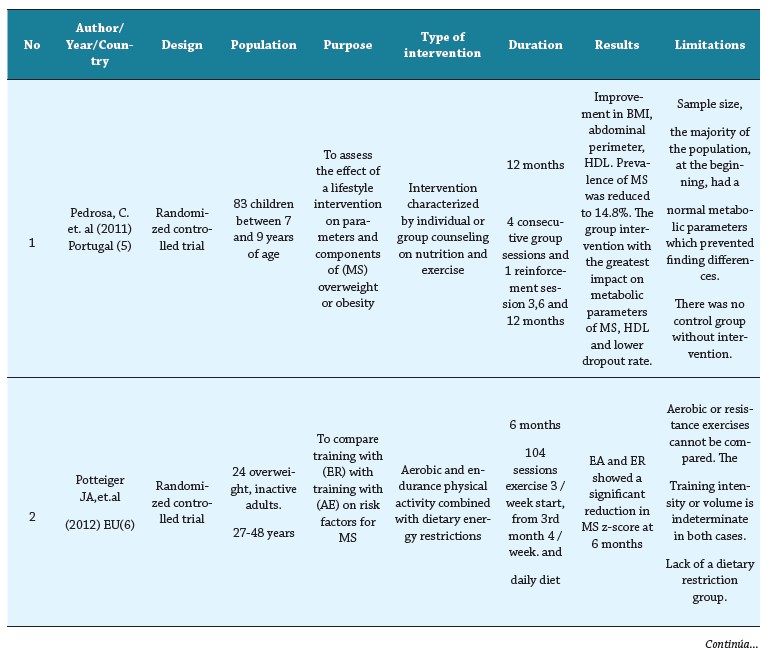
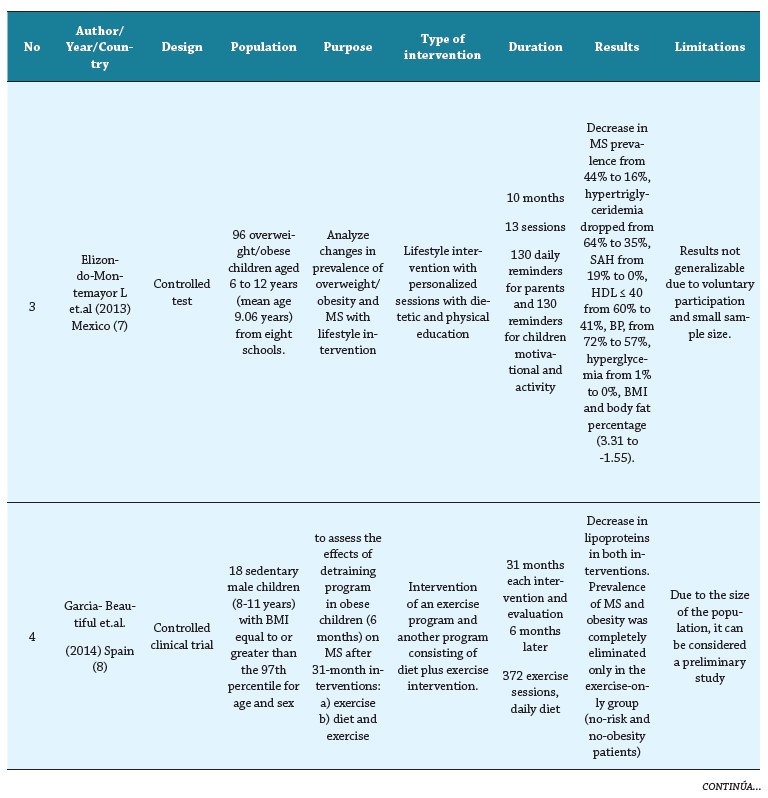
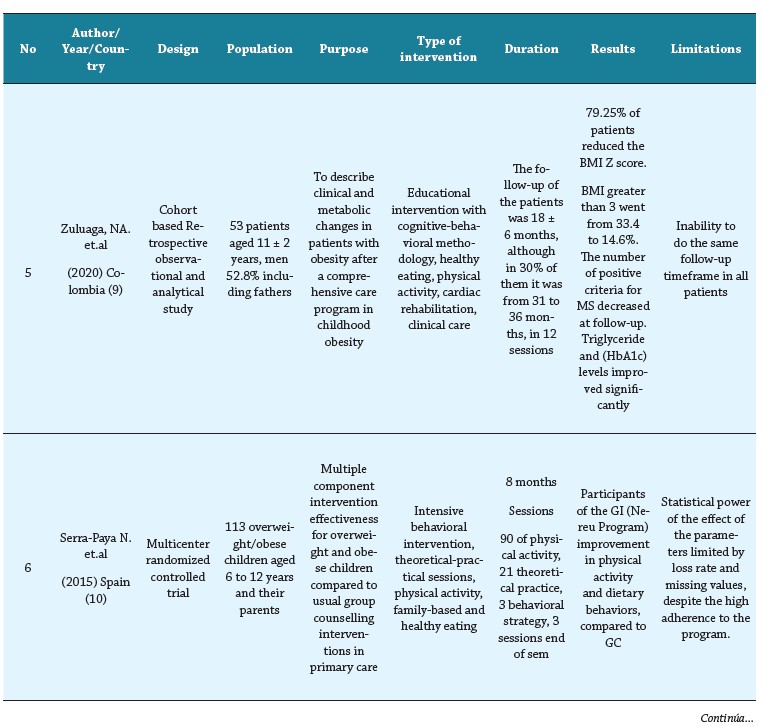
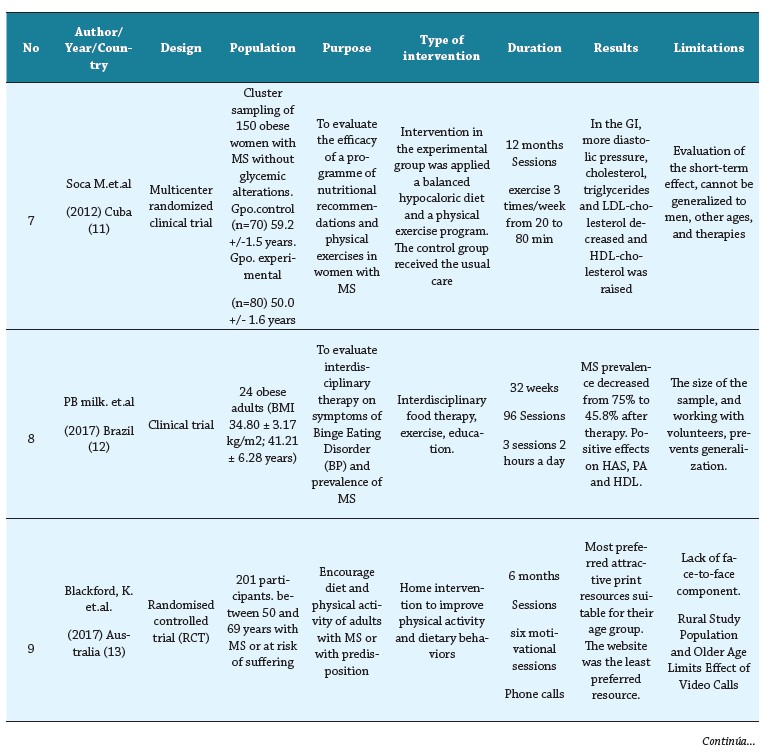
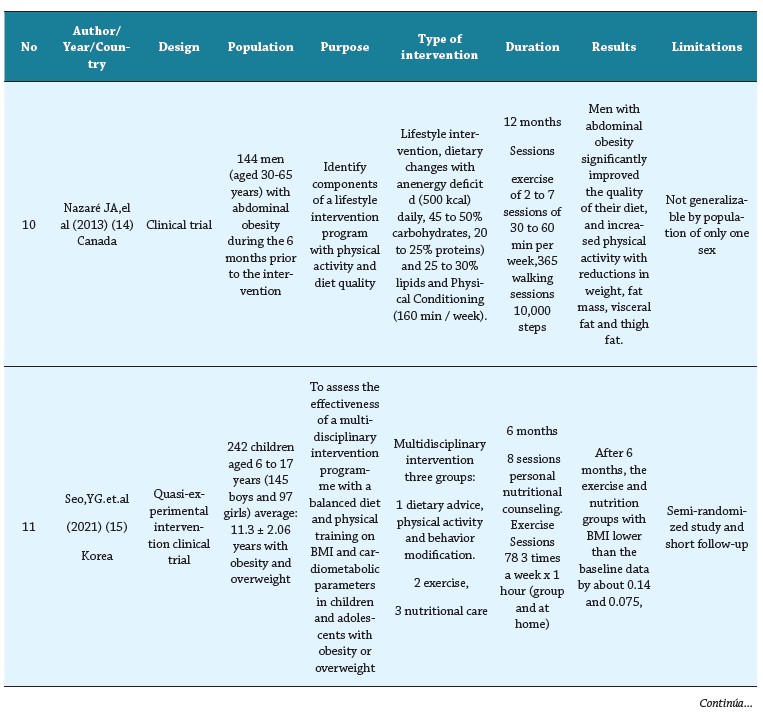
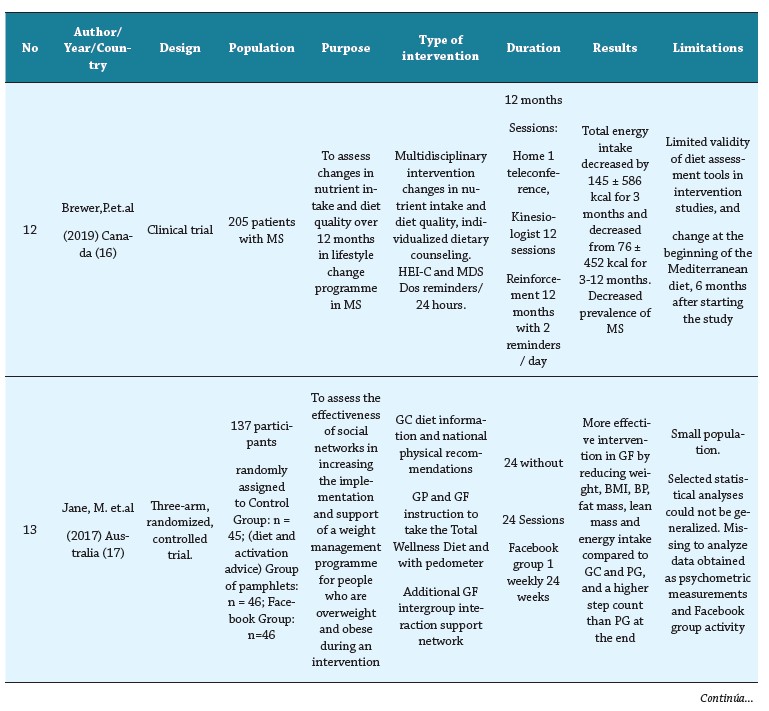
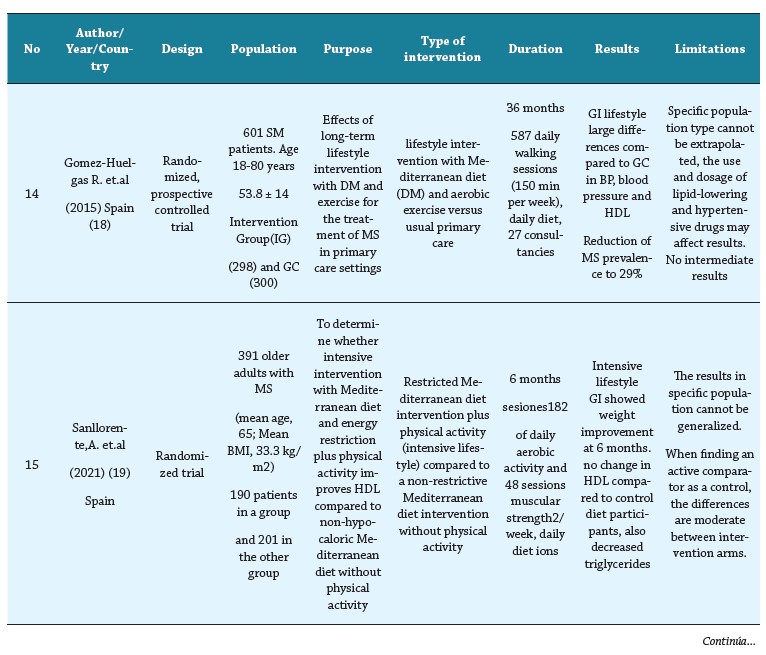
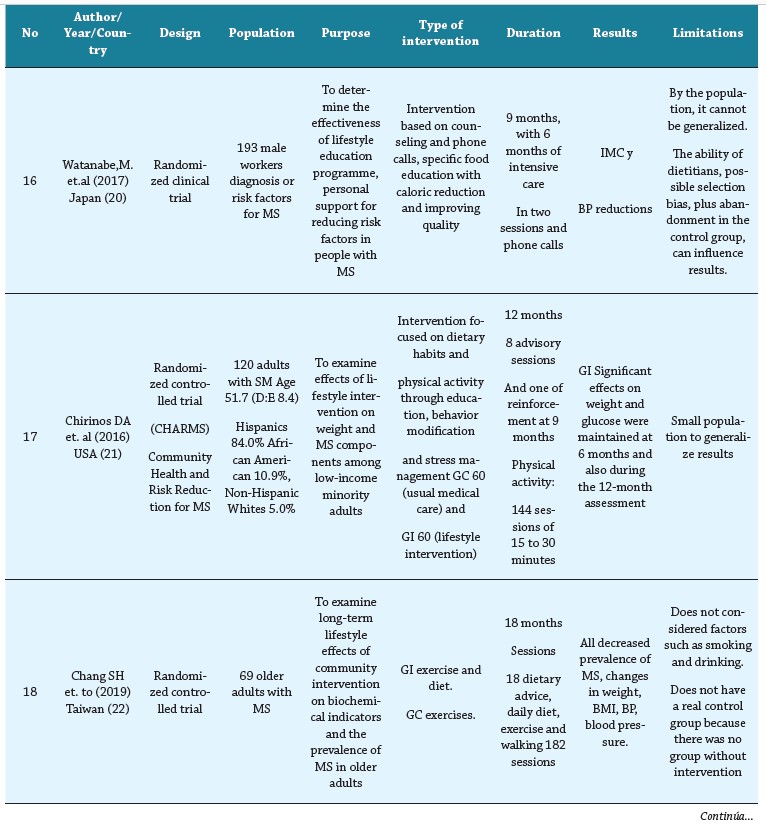
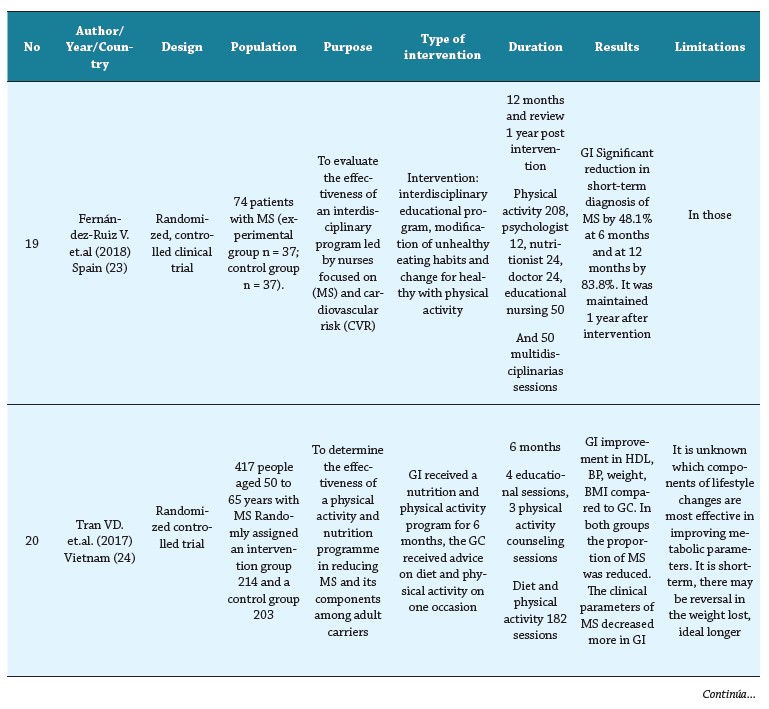


A decrease in the prevalence of MS, and/or its cardiometabolic parameters contemplated in the quantification studies at the beginning, and whose condition was modified in the course of the intervention, was classified as good of the intervention.
Interventions in Children
A total of 605 participants between the ages of 6 and 17 were included in the analysis. The duration was between 6 and 31 months. One of the interventions for children assessed the effect of detraining after 31 months of intervention; the remaining 5 studies were educational and mul-tidisciplinary lifestyle interventions. In one study, individual educational counseling compared with group counseling on good nutrition and exercise, the latter had a better effect by decreasing MS parameters, showing less dropout. An educational intervention in the school environment focused on lifestyle, personalized by instructing parents or caregivers, significantly decreased all parameters, as well as the prevalence of MS. There was no negative effect on detraining 6 months after diet and exercise interventions. Educational intervention aimed at patients and parents, or caregivers combined with physical activity sessions, reduced the criteria as the diagnosis of MS improved. The Nereu program, characterized by behavioral interventions for children and families in an integrated manner, presented an improvement in eating and physical behaviors. In multidisciplinary intervals with constant physical activation and adequate feeding, MS parameters were reduced. Interventions in children in food and physical counselling showed improvement in clinical parameters and decreased MS prevalence.
Interventions in Adults
There were 3448 adults included in the reviewed studies, with ages between 27 and 69 years. Adult interventions lasted between 6 and 36 months. Four interventions did not include females in the sample; however, results did not differ from those found in populations of both sexes. The interventions positively impacted the clinical parameters of MS, reduced its prevalence, or achieved a change in eating behavior and physical activity.
DISCUSSION
The result of our review supports previous findings (Aguilar et.al, 2014) which found that, if in an intervention includes physical activity, diet, and reinforcements (positive???), better results are obtained. The collaboration of the family is a factor of greater impact than food education itself, when it comes to guaranteeing results. In the present (28) review, group counseling was effective among children, and the use of motivational reminders against sedentary lifestyle were regarded as useful tools. The group approach reinforced adherence. Personalized, multidisciplinary care in children with family support offers success in acquiring healthy lifestyles such as diet and physical activation.
Regardless of a personalized or group intervention for children, family involvement helped decrease MS, overweight, and obesity. When the mixed intervention included diet, there are good results in decreasing MS. The Mediterranean diet, which was the most implemented in the present review, shows good reduction of energy intake, optimization of the regimen with 24-hour reminders, constant nutritional advice, and ideas for adaptations to the Mediterranean diet.
The symptoms of binge eating disorder, which are excessive and recurrent food intake, with the feeling of losing control, without compensatory and appropriate weight control behaviors, were controlled in one of the multidisciplinary interventions, as well as the decrease in the prevalence of MS from 75% to 45% and changes in metabolic parameters. (29) Binge eating disorder (BED) is considered the most prevalent food disorder, and a major risk factor for obesity and MS. (30)
Findings from educational home intervention on healthy lifestyles in adults from rural communities in Australia (Blackford K, et.al, 2019) (19) suggest the majority of people in this study preferred printed resources to the Internet. We considered that this phenomenon could be attributable to population characteristics such as age, rurality, and disinterest in access to technology. This result contrasts with another Australian study (Jane M et al., 2017) (23), which found that using the web (Facebook) worked as an excellent tool as a support network to modify diet and physical activity for weight control. It appears that technology could serve as a barrier or facilitator, depending on the population group, when addressing MS in different population groups.
We found similarity with what was stated by Yamaoka K et al. (2012) in relation to the improvement of the cardiometric parameters (31) of MS since the lifestyle interventions in the significantly reduced the mean values of blood pressure and the abdominal perimeter.
Evidence from clinical trials (32, 33, and 34) has shown that the key points to prevent diabetes in adults are increased physical activity and weight loss. In people at risk of developing type 2 diabetes, it was possible to reduce the risk by 50 to 60% in the intervention period of 3 to 6 years, through the combination of diet, exercise, with the objectives of weight loss and increase in physical activation and, despite decreasing, the effect of the intervention may continue (35, 36, and 37). The large-scale implementation of dietary interventions and physical activity in clinical settings and communities is beginning to be carried out, but requires dissemination.
It is not yet decisive how it is recommended to carry out the reinforcement and if it is different in children or adults, since the maintenance phase must be structured to extend as long as possible the change of behavior and habits that favor the healthy lifestyle become customary. Having access to information technologies motivates us to imagine that the maintenance of what has been learned in the interventions will be strengthened with interactive virtual programs and constant communication for the user, and that it will possibly be an accessible instrument in interventions for children.
In the present review, one study (Fernández-Ruiz et al., 2018) (30) demonstrated effectiveness and efficacy in MS reduction of an interdisciplinary nursing-guided intervention at 6, 12, and 24 months, respectively, with a reduction in metabolic syndrome of 83.8% at 12 months. The literature suggests that interventions that transmit knowledge, modify sedentary lifestyle, change dietary patterns, promote self-care, and promote self-responsibility, positively change the health conditions of society. The literature also suggests that reinforcement is indispensable for permanent change.
Findings from this literature review support previous findings (Dunkley AJ et al., 2012) (38) that any interventions is useful to reverse metabolic syndrome, but multidisciplinary lifestyle interventions (Guzmán A et al., 2019) are more effective by promoting the acquisition of behaviors that modify and prevent metabolic syndrome in a more lasting way. Based on this review, a minimum of 24 weeks is ideal for optimal results.
CONCLUSIONS
Attention to MS includes the reduction of its causes (obesity and physical inactivity) and the treatment of associated risk factors through the modification of lifestyles, especially nutritional habits and physical activity. In children, interventions in school environments control and decrease MS, group participation leads to a lower dropout rate, there is more effectiveness in integrating the family, and the reduction in prevalence in individual or group programs is similar.
More experience and implementation of adaptable and modifiable models in the different populations at risk is required, to be able to make primary care more efficient and effective in the management and knowledge of metabolic syndrome, and realize the importance of intervening, as well as disseminating throughout the population, the tangible benefits of stopping before the appearance of something that will bring the imminent deterioration of health.
Interventions that combine the promotion of healthy lifestyles, diet, and physical activation show a clear improvement in the prevalence of metabolic syndrome, as well as in decreasing the number of cardiometabolic risk factors in the people under study. Programs are effective in a wide range of characteristics, but interdisciplinary lifestyle interventions seem to be better at achieving the desired goal. It is necessary to implement long-term designed interventions, and to monitor the results to know which objectives that were achieved in the control are the most impactful, and how to make them permanent through reinforcement, evaluation, and continuous feedback, to achieve effective strategies to prevent and control Metabolic Syndrome, and that could be managed as health policies.
Contribution of the authors
All authors have approved the final version of the article.
Conflict of interests
The authors of this review declare that they have no conflicts of interest.
REFERENCES
1 De Fronzo RA, Ferrannini E. Insulin resistance. A multifaceted syndrome responsible for NIDDM, obesity, hypertension, dyslipidemia, and atherosclerotic cardiovascular disease. Diabetes Care. 1991; 14(3):173-94 1.
2 Alberti KG, Eckel RH, Grundy SM, Zimmet PZ, Cleeman JI, Donato KA, et al. Harmonizing themeta-bolic syndrome: a joint interim statement of the International Diabetes Federation Task Force on Epidemiology and Prevention; National Heart, Lung, and Blood Institute; American Heart Association; World Heart Federation; International Atherosclerosis Society; and InternationalAssociation for the Study of obesity. Circulation. 2009; 120(16):1640-5.
3 Latin American Consensus of the Latin American Diabetes Association (ALAD). Epidemiology, diagnosis, control, prevention and treatment of metabolic syndrome in adults. Rev Asoc Latinoam Diab. 2010;18(1):25-44.
4 Alberti KG, Zimmet P, Shaw J. Metabolic syndrome: a new world definition. Consensus Statement of the International Diabetes Federation. Diabetic Medicine: A journal of the British Diabetic Association. 2006;23:469-8.
5 Pedrosa C, Oliveira BM, Albuquerque I, Simons-Pereira C, Vaz-de-Almeida MD, Correia F. Markers of metabolic syndrome in obese children before and after 1-year lifestyle intervention program. Eur J Nutr. 2011 Sep; 50(6):391-400. doi: 10.1007/s00394-010-0148-1. Epub 2010 Nov 25. PMID: 21107585.
6 Potteiger AND Claytor RP Hulver MW, Hughes MR, Carper MJ, Richmond S,Thyfault JP. Resistance exercise and aerobic exercise when paired with dietaryenergy restriction both reduce the clinical components of metabolic syndrome inpreviously physically inactive males. Eur J Appl Physiol. 2012 Jun; 112(6):2035-44. doi: 10.1007/s00421-011-2174-y. Epub 2011 Sep 23. PMID: 21947428.
7 Elizondo-Montemayor L, Gutierrez NG, Moreno DM, Martínez U, Tamargo D, Treviño M. School-based individualised lifestyle intervention decreases obesity and the metabolic syndrome in Mexican children. J Hum Nutr Diet. 2013 Jul; 26 Suppl 1:82-9. doi: 10.1111/jhn.12070. Epub 2013 Apr 19. PMID: 23600808.
8 García Hermoso A, Saavedra García JM, Escalante González Y, DomínguezPachón AM. Effect of long-term physical exercise program and/or diet onmetabolic syndrome in obese boys. NutrHosp. 2014 Jul 1; 30(1):94-103. doi:10.3305/nh.2014.30.1.7448. PMID: 25137267.
9 Zuluaga NA, Osorno A, Lozano A, Villada O. Clinical and metabolic effect ofa multidisciplinary intervention through a comprehensive care program for children and adolescents with obesity. Biomedica. 2020 Mar 1; 40(1):166-184.English, Spanish. doi: 10.7705/biomedica.4593. PMID: 32220172; PMCID:PMC7357374.
10 Serra-Paya N, Taught A, Castro-Vignettes I, Real J, Sinfreu-Bergués X, Zapata A, Wall JM, Galindo-Ortego G, Solé-Mir E, Teixido C. Effectiveness of a Multi-Component Intervention for Overweight and Obese Children (Nereu Program): A Randomized Controlled Trial. PLoS One. 2015 Dec 14; 10(12):e0144502. doi: 10.1371/journal.pone.0144502. PMID: 26658988; PMCID: PMC4684233.
11 Soca M et.al. Primary Care Randomized Clinical Trial: Role of Diet and Physical Exercise in Women with Metabolic Syndrome Volume 44, Issue 7, July 2012, Pages 387-393 Randomized Clinical Trial: Role of Diet and Physical Exercise in Women with Metabolic Syndrome.
12 Milk PB, Damaso AR, Poli VS, Sanches RB, Silva SGA, Fidalgo JPN, Nascimento MA, de Oliveira CAM, Caranti DA. Long-term interdisciplinary therapy decreases symptoms of binge eating disorder and prevalence of metabolic síndrome in adults with obesity. Nutr Res. 2017 Apr; 40: 57-64. doi: 10.1016/j.nutres.2017.03.006. Epub 2017 Mar 15. PMID: 28473061.
13 Blackford K, Lee A, James AP, Waddell T, Hills AP, Anderson AS, Howat PJancey J. Process evaluation of the Albany Physical Activity and Nutrition(APAN) program, a home-based intervention for metabolic syndrome and associated chronic disease risk in rural Australian adults. Health Promot J Austr. 2017 Mar; 28(1):8-14. doi: 10.1071/HE16027. PMID: 27426475.
14 Nazarene JA, Smith J, Borel TO THE Alméras N, Tremblay A, Bergeron J, Poirier P,After JP. Changes in both global diet quality and physical activity level synergistically reduce visceral adiposity in men with features of metabolic syndrome. J Nutr. 2013 Jul; 143(7):1074-83. two: 10.3945/jn.113.175273. Epub 2013 May 29. PMID: 23719226.
15 Seo YG, Lim H, Kim Y, Ju YS, Choi YJ, Lee HJ, Jang HB, Park SI, Park KH. Effects of circuit training or a nutritional intervention on body mass index andother cardiometabolic outcomes in children and adolescents with overweight or obesity. PLoS One. 2021 Jan 28; 16(1):e0245875. doi: 10.1371/journal.pone.0245875. PMID: 33507953; PMCID: PMC7842905.
16 Brewer P, Royall D, Li A, Rodriguez A, Green J, Macklin S, Craig A, PasanenJ, Brunelle L, Maitland S, Dhaliwal R, Klein D, Tremblay A, Rheaume C, Mutch DM, Jeejeebhoy K. Nutrient intake and dietary quality changes within a personalized lifestyle intervention program for metabolic syndrome in primary care. ApplPhysiol Nutr Metab. 2019 Dec; 44(12):1297-1304. doi: 10.1139/apnm-2019-0070. Epub 2019 Apr 30. PMID: 31039319.
17 Jane M, Hagger M, Foster J, Ho S, Kane R, Pal S. Effects of a weight management program delivered by social media on weight and metabolic síndrome risk factors in overweight and obese adults: A randomised controlled trial. PLoS One. 2017 Jun 2; 12(6):e0178326. doi: 10.1371/journal.pone.0178326. PMID: 28575048; PMCID: PMC5456050.
18 Gomez-Huelgas R, Jansen-Chaparro S, Baca-Osorio AJ, Mancera-Romero J,Tinahones FJ,Bernal-López MR. Effects of a long-term lifestyle intervention program with Mediterranean diet and exercise for the management of patients with metabolic syndrome in a primary care setting. Eur J Intern Med. 2015 Jun; 26(5):317-23. doi: 10.1016/j.ejim.2015.04.007. Epub 2015 Apr 20. PMID:25907985.
19 Sanllorente A, Soria-Florido MT, Castañer O, Lassale C, Salas-Salvadó J,Martinez-González Má, Su-birana I, Ros E, Corella D, Estruch R, Tinahones FJ,Hernáez á, Fitó M. A lifestyle intervention with an energy-restricted Mediterranean diet and physical activity enhances HDL function: a substudy of the PREDIMED-Plus randomized controlled trial. Am J Clin Nutr. 2021 Nov 8; 114(5):1666-1674. doi: 10.1093/ajcn/nqab246. PMID: 34582548.
20 Watanabe M, Yokotsuka M, Yamaoka K, Adachi M, Nemoto A, Tango T. Effects of a lifestyle modification programme to reduce the number of risk factors for metabolic syndrome: a randomised controlled trial. Public Health Nutr. 2017 Jan; 20(1):142-153. doi: 10.1017/S1368980016001920. Epub 2016 Jul 29. PMID: 27469421; PMCID: PMC5197611.
21 Chirinos DA, Goldberg RB, Llabre MM, Gellman M, Gutt M, McCalla J, Mendez A, Schneiderman N. Lifestyle modification and weight reduction among low-income patients with the metabolic syndrome: the CHARMS randomized controlled trial. J Behav Med. 2016 Jun; 39(3):483-92. doi: 10.1007/ s10865-016-9721-2. Epub 2016 Feb 4. PMID: 26846133.
22 Chang SH, Dog NH Yu CY. Long-Term Lifestyle Intervention in Elderly With Metabolic Syndrome. Clin Nurs Res. 2019 Jul; 28(6):658-675. doi: 10.1177/1054773817749923. Epub 2017 Dec 24. PMID: 29276844.
23 Fernández-Ruiz VE, Paniagua-Urbano JA, Solé-Agustí M, Ruiz-Sánchez A,Gomez-Marín J, Armero-Barranco D. Effectiveness of the I<sup>2</sup>AO<sup>2</sup> interdisciplinary programme led by nurses onmetabolic syndrome and cardiovascular risk: a randomized, controlled trial. J Int Med Res. 2018 Jun; 46(6):2202-2218. doi: 10.1177/0300060518757604. Epub 2018 Mar 27. PMID: 29584539; PMCID: PMC6023074.
24 Tran VD, James AP, Lee AH, Jancey J, Howat PA, Thi Phuong Mai L.Effectiveness of a Community-Based Physical Activity and Nutrition BehaviorIntervention on Features of the Metabolic Syndrome: A Cluster-Randomized Controlled Trial. Metab Syndr Relat Disord. 2017 Mar; 15(2):63-71. doi:10.1089/ met.2016.0113. Epub 2016 Dec 20. PMID: 27997282.
25 Yoo S, Kim H, Cho HI. Improvements in the metabolic syndrome and stages of change for lifestyle behaviors in Korean older adults. Osong Public Health Res Pespect. 2012; 3:85-93. https://doi.org/10.1016/j.phrp.2012.04.007.
26 Siu PM, Angus PY, Benzie IF, Woo J. Effects of 1-year yoga on cardiovascular risk factors in middle-aged and older adults with metabolic syndrome: A randomized trial. Diabetol Metab Syndr. 2015;7: 40. https://doi.org/10.1186/s13098-015-0034-3.
27 Ortega JF, Morales-Palomo F, Fernandez-Elias In Hamouti N, Bernardo FJ,Martin-Doimeadios RC, Nelson RK, Horowitz JF, Mora-Rodriguez R. Dietary supplementation with omega-3 fatty acids and oleate enhances exercise trainingeffects in patients with metabolic syndrome. Obesity (Silver Spring). 2016Aug; 24(8):1704-11. doi: 10.1002/oby.21552. Epub 2016 Jun 29. PMID: 27356240.
28 Aguilar MJ, et al. Physical activity programs to reduce overweight and obesity in children and adolescents; systematic review. Nutr Hosp. 2014; 30(4):727-40.
29 American Psychiatric Association. Diagnostic and Statistical Manual of Mental Disorders. 4. Washington, DC: 1994. DSM-IV.
30 Udo T, McKee SA, White MA, Masheb RM, Barnes RD, Grilo CM. The factor structure of the metabolic syndrome in obese individuals with binge eating disorder. J Psychosom Res. 2014 Feb; 76(2):152-7. doi: 10.1016/j.jpsychores.2013.10.007. Epub 2013 Oct 18. PMID: 24439692; PMCID: PMC3953028.
31 Yamaoka K, Tango T. Effects of lifestyle modification on metabolic syndrome: a systematic review and meta-analysis. BMC Med 2012;10:138.
32 Tuomilehto J, Lindström J , Eriksson JG , Valle TT, Hämäläinen H , Ilanne-Parikka P , et al; Finnish Diabetes Prevention Study Group. Prevention of type 2 diabetes mellitus through lifestyle changes among subjects with glucose intolerance. N Engl J Med. 2001; 344: 1343-50. [PMID: 11333990].
33 Pan XR, Li GW, Hu YH, Wang JX, Yang WY, An ZX, et al. Effects of diet and exercise on the prevention of NIDDM in people with glucose intolerance. The Da Qing IGT and the Diabetes Study. Diabetes care. 1997; 20: 537-44. [PMID: 9096977].
34 Albright AL, Gregg EW. Prevention of Type 2 Diabetes in U.S. Communities: The National Diabetes Prevention Program. Am J Prev Med. 2013; 44: S346-51. [PMID: 23498297] doi:10.1016/j.amepre.2012.12.009.
35 Knowler WC, Fowler SE, Hamman RF, Christophi CAI haveHJ ffman, Brenneman AT, et al; Research Group of the Diabetes Prevention Program. 10-year follow-up of diabetes incidence and weight loss in the Diabetes Prevention Program Outcome Study. Lancet. 2009; 374: 1677-86. [PMID: 19878986] doi:10.1016/S0140-6736(09)61457-4.
36 Li G, Zhang P, Wang J, An Y, Gong Q, Gregg EW, et al. Cardiovascular mortality, all-cause mortality, and incidence of diabetes after lifestyle intervention for people with glucose intolerance in the Da Qing Diabetes Prevention Study: A 23-year follow-up study. Lancet Diabetes Endocrinol. 2014; 2: 47480. [PMID: 24731674] doi:10.1016/S2213-8587(14)70057-9.
37 Lindstrom J, Ilanne-Parikka P , Peltonen M , Aunola S , Eriksson JG, Hemiö K , et al; Finnish Diabetes Prevention Study Group. Sustained reduction in the incidence of type 2 diabetes through lifestyle intervention: follow-up to the Finnish Diabetes Prevention Study. Lancet. 2006; 368: 1673-9. [PMID: 17098085].
38 Dunkley AJ, Charles K, Gray LJ, Camosso-Stefinovic J, Davies MJ, Khunti K. Effectiveness of interventions for reducing diabetes and cardiovascular disease risk in people with metabolic syndrome: Systematic review and mixed treament comparison meta-analysis. Diabetes Obes Metab. 2012;14:616-25.